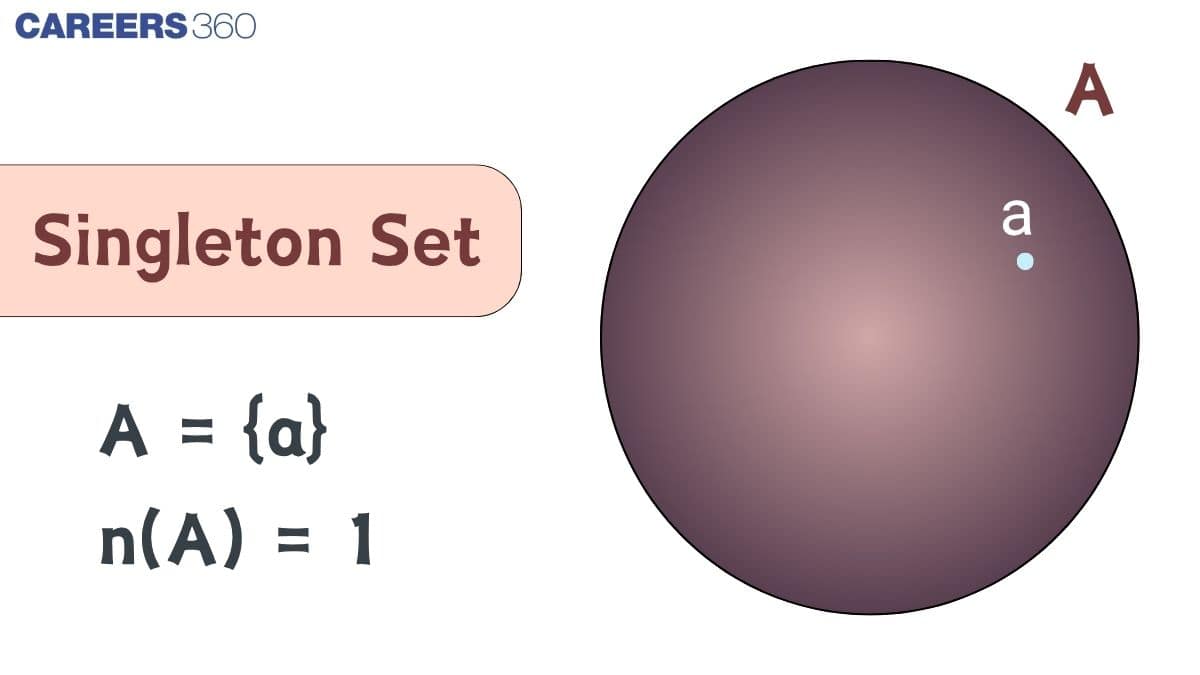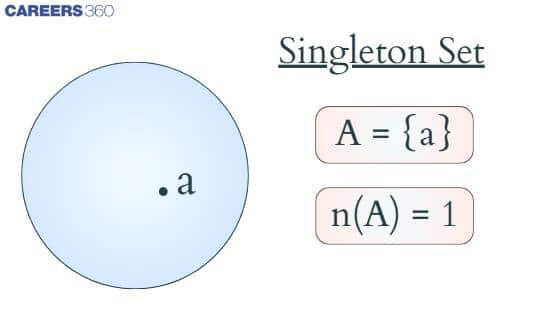Singleton set
A singleton set is a fundamental concept in set theory, referring to a set that contains exactly one distinct element. It plays a crucial role in understanding the basics of sets in mathematics and is often introduced in early algebra and logic studies. Whether you're exploring types of sets, set notation, or Cardinality of Sets, grasping the idea of a singleton set is essential for building a strong mathematical foundation. In this article, we will explain the definition, properties, and real-life examples of singleton sets in detail.
This Story also Contains
- Overview of Sets
- Singleton set definition
- Properties of Singleton Set
- Singleton Set vs Empty Set
- Facts about Singleton Set
- Singleton Set vs Other Types of Sets
- Real-Life Examples of Singleton Sets
- Solved Examples Based On the Singleton Sets
- List of Topics Related to Singleton Set
- NCERT Resources
- Practice Questions

Overview of Sets
A set is simply a collection of distinct objects, considered as a whole. These objects, called elements or members of the set, can be anything: numbers, people, letters, etc. Sets are instrumental in defining and working with groups of objects that share common properties.
It is a well-defined collection of distinct objects, and it is usually denoted by capital letters $A, B, C, S, U, V$......
If $a$ is an element of a set $A$, we say that " a belongs to $A$ ." The Greek symbol $\in$ is used to denote the phrase 'belongs to'.
Singleton set definition
A set having one element is called a singleton set.
Let's look into singleton set examples.
The examples of singleton set includes $\{3\},\{b\}$, $\{\phi\}$, $\{\{1,2,3\}\}$.
$\{\{1,2,3\}\}$ is also singleton as it has one element which is a set.
$\{\phi\}$ is also a singleton set.
Singleton Set Venn Diagram
Let $A =\{a\}$. The Venn diagram of the singleton set $A$ is

Properties of Singleton Set
The properties of a singleton set include,
- A singleton set contains exactly one element; its cardinality is 1.
- The singleton set has two subsets.
- Each element in a singleton set is unique within that set.
- The two subsets of a singleton set are the null set and the singleton set itself.
- The power set of a singleton set includes the empty set and the singleton set itself.
Cardinality of Singleton Set
The number of elements in a set is called the cardinality of the set. Thus, the cardinality or the number of elements in a singleton set is $1$.
Power Set of a Singleton Set
The power set of a set is the set of all subsets of the given set. The number of subsets of a singleton set is two. One subset is the empty set $(∅)$, and the other is the set itself. Thus, the power set of any singleton set always contains only $2$ elements.
Is the Zero Set a Singleton Set?
The zero set $\{0\}$ is a set with “$0$” as the only element. Thus, it is a singleton set.
Note that the singleton set $\{0\}$ is not to be confused with an empty set. An empty set is a set that has no elements. It is completely null or void.
Singleton Set vs Empty Set
| Singleton Set | Empty Set |
| A singleton set contains only one element.
| An empty set has no elements. |
| A singleton set with element $x$ is denoted by $\{x\}$. | An empty set is denoted by the symbol $∅$. It is also expressed as $\{\}$. |
| If A$=\{a\}$, then $n(A)=1$. | $n(∅)=0$ |
| Other names are unit set, one-point set. | Other names are null set, void set. |
| An empty set is always a subset of a singleton set. | The empty set is the only subset of itself. |
Facts about Singleton Set
- Singleton sets are also known as unit sets.
- The cardinality of a singleton set is 1.
- Singleton sets are always finite sets.
- Singleton sets are commonly used in mathematics to represent unique elements.
- Every set that contains the single element of a singleton set is its superset. In other words, a singleton set is a subset of every set that contains its single element.
Singleton Set vs Other Types of Sets
Understanding the difference between a singleton set and other types of sets is crucial for mastering the fundamentals of set theory. Below are detailed comparisons that highlight how a singleton set stands apart from other commonly discussed sets in mathematics.
Comparison with Empty Set (Null Set)
A singleton set contains exactly one unique element, whereas an empty set (also called the null set) contains no elements at all.
- Singleton set: $A = \{5\}$
- Empty set: $B = \{\}$ or $B = \emptyset$
Although both sets are finite, the cardinality (number of elements) differs: - $n(A) = 1$
- $n(B) = 0$
- The key difference between a singleton set and a null set lies in the presence or absence of elements. In mathematics, both play important roles in defining boundaries of sets, but they are not equal in value or usage.
Comparison with Finite and Infinite Sets
A singleton set is a specific type of finite set, since it contains a limited number of elements: only one.
- Example of a singleton (finite) set: $C = \{x\}$
- Example of an infinite set: $D = \{1, 2, 3, \ldots\}$
All singleton sets are finite, but not all finite sets are singleton sets. The difference between a singleton set and an infinite set is fundamental: the latter has no fixed count of elements, making singleton sets much simpler to analyse and represent.
Differences from Equivalent and Equal Sets
- Two sets are equal if they have exactly the same elements.
- Two sets are equivalent if they have the same number of elements, regardless of the actual content.
A singleton set is equal to another singleton set only if both contain the same element: - $E = \{2\}$ and $F = \{2\}$ are equal: $E = F$
- $G = \{2\}$ and $H = \{4\}$ are not equal but are equivalent since both have cardinality 1: $n(G) = n(H) = 1$
Thus, singleton set vs equivalent set comparison helps in understanding deeper aspects of set relationships and counting principles.
Real-Life Examples of Singleton Sets
Singleton sets may seem abstract, but they appear in many real-world and academic scenarios. Here are some practical examples of singleton sets to better understand their significance.
Daily Life Scenarios Representing Singleton Sets
- A person who owns only one mobile phone: $M = \{\text{"iPhone"}\}$
- A bag that contains only one pen: $P = \{\text{"blue pen"}\}$
These are classic real-life examples of singleton sets, where the set contains only a single item, making them ideal for clear classification and counting.
Educational or Practical Use Cases
In schools or exams, you might encounter a question such as:
"List the set of students who scored exactly 100 marks in Mathematics."
If only one student achieved it, the set would be:
$S = \{\text{"Ravi"}\}$
This is an example of a singleton set in an academic context, demonstrating its use in data analysis, classification, and reporting.
Singleton Set in Computer Science or Data Structures
In computer science, a singleton set can be used to represent a unique user ID, a single element in a stack, or even a singleton object in design patterns.
For example, a set containing a single IP address accessing a server:
$IP = \{\text{"192.168.0.1"}\}$
This is a direct application of singleton sets in computer programming, where sets are often used for uniqueness, hashing, and memory-efficient representation of single elements.
Solved Examples Based On the Singleton Sets
Question 1. Which of the following is not a singleton set?
1) A set of all natural numbers which are neither a prime nor a composite number.
2) Set of even prime numbers.
3) Set of numbers that divide $12$ and $20$.
4) $\mathrm{S}=\{\phi\}$.
Solution
(1) set $=\{1\}$
(2) set $=\{2\}$
(3) There are two numbers that divide $12$ and $20$ i.e. $2$ and $4$. So, the set is $\{2,4\}$.
(4) $\{\phi\}$ is a singleton set with one element $\phi$.
Hence, the answer is option (3).
Question 2. Which of the following is a singleton set?
1) $\phi$
2) $\{\phi\}$
3) $\left\{x: x^2-4=0\right\}$
4) None of these
Solution
(1) $\phi$
The number of elements is zero. So, not a singleton set.
(2) $\{\phi\}$
This set has one element: $\phi$
So, it is a singleton
(3) This set is $\{2,-2\}$.
So, not a singleton.
Hence, the answer is option (2)
Question 3. Which of the following is not a singleton set?
1) $\{x: x>5$ and $x<7$ and $x$ is a natural number $\}$
2) $\left\{x: x^2=9\right.$ and $x$ is a positive integer $\}$
3) $\left\{x: x^2=9\right.$ and $x$ is a negative integer $\}$
4) $\left\{x: x^2-3 x+2=0\right.$ and $x$ is a positive integer $\}$
Solution
Singleton Set: A set that has only one element. eg. $\{3\}, \{b\}$
In this Question,
$A= \{6\}$,
$B=\{3\}$,
$C=\{-3\}$
D) $x^2-3 x+2=0 \Rightarrow x=1,2$ and both are positive
So, this set has 2 elements, and thus it is not a singleton
Hence, the answer is option (4).
List of Topics Related to Singleton Set
To fully understand the concept of a singleton set, it’s important to explore its related set theory topics. These foundational concepts help clarify how singleton sets function within the broader framework of mathematical sets. In this section, we cover all key topics connected to singleton sets.
NCERT Resources
Explore essential NCERT study materials for Sets, with comprehensive solutions, concise revision notes, and curated exemplar problems. These resources are designed to enhance your conceptual clarity and prepare you effectively for board and competitive exams.
NCERT Solutions for Class 11 Chapter 1 Sets
Practice Questions
This section offers a set of carefully designed practice questions based on power sets, union, intersection, and difference of sets, aimed at reinforcing your understanding of key set theory concepts.
| Intersection Of Set, Properties Of Intersection - Practice Question MCQ |
| Complement Of A Set Law Of Complement Property Of Complement - Practice Question MCQ |
Frequently Asked Questions (FAQs)
A set which is having only one element is called a singleton set.
The singleton set is also called a unit set.
The power of the singleton set is 2.